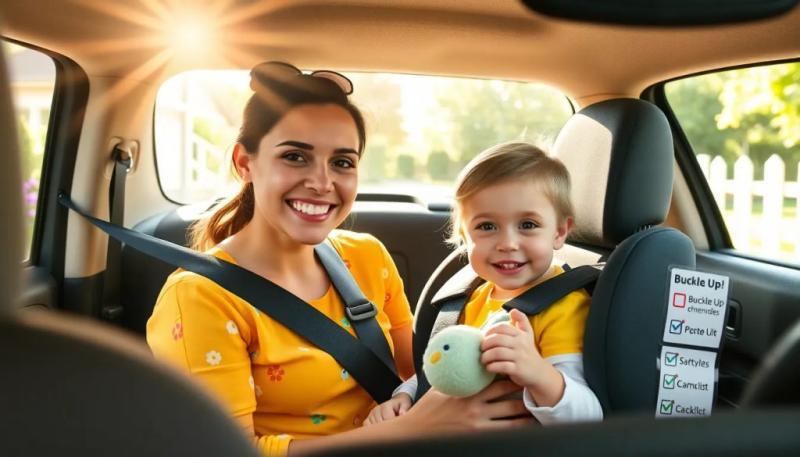Ensuring your children’s safety while in the care of a nanny is paramount, especially when it comes to driving. With the right babysitter car safety rules, you can have peace of mind knowing your kids are secure. This article explores essential guidelines and practices to follow when allowing a nanny to drive your children.
10 must-dos before having the nanny or sitter drive the kids
Before allowing your nanny to transport your children, consider these critical steps:
- Check driving records: Always verify the nanny's driving history to ensure they have a clean record.
- Conduct background checks: Thorough background checks can help identify any potential risks.
- Discuss safety guidelines: Clearly communicate your expectations regarding safe driving practices.
- Consider car conditions: Ensure that the vehicle used meets all safety standards and is properly maintained.
- Verify car seat installation: Make sure that child car seats are installed correctly for maximum safety.
It’s also essential to set rules about distractions. For example, texting or using a phone while driving should be strictly prohibited. Moreover, establishing guidelines for speed limits can significantly reduce the risk of accidents.
Another important aspect involves planning test drives before any trip. Observing the nanny's driving can provide insights into their skills and comfort level on the road. This evaluation will help you decide if they are a suitable driver for your children.
Child car seat safety: guidelines for babysitters
Understanding child car seat safety is crucial for any nanny or babysitter responsible for transporting children. Here are some important guidelines to follow:
- Choose the right seat: Select a car seat appropriate for the child’s age, weight, and height.
- Proper installation: Always ensure that the car seat is installed securely according to the manufacturer's instructions.
- Use tethers and anchors: Make use of additional safety features like tether straps for added security.
- Regular checks: Regularly check the car seat for any wear and tear and replace as necessary.
Nannies should also familiarize themselves with local laws regarding car seat regulations to ensure compliance. In many places, specific laws dictate the type of seats and usage based on a child's age and size.
Lastly, educating children about proper seatbelt use can reinforce the importance of car safety from young ages. This helps to cultivate a culture of safety that extends beyond transportation.
4 car safety tips for nannies to follow
When it comes to ensuring safety during drives, there are a few key practices that every nanny should adhere to:
- Stay alert: Nannies should always be aware of their surroundings and avoid distractions while driving.
- Follow speed limits: Adhering to speed limits is crucial to minimize risks on the road.
- Never drive under the influence: It’s essential to avoid any substances that could impair your ability to drive.
- Keep emergency contacts handy: Have a list of emergency contacts easily accessible in the vehicle.
Nannies should also maintain a calm demeanor while driving, as children can easily pick up on stress or anxiety. This not only makes for a more pleasant journey but is also vital for ensuring safety.
Regularly reminding children about behavior in the car can help reinforce good habits, such as sitting still and keeping their seatbelts fastened.
Safety first: a nanny’s guide to ensuring a safe ride for kids
Safety should always be the top priority for nannies driving children. Here are some important aspects to keep in mind:
First, practicing defensive driving can significantly reduce the likelihood of accidents. This includes anticipating potential hazards and reacting accordingly. Additionally, keeping a safe distance from other vehicles can provide extra time to respond to unexpected situations.
Another key factor is to always use appropriate car seats and seatbelts for every child. If a child is old enough to use a seatbelt, ensure it fits properly across their chest and lap.
Moreover, implementing a no-phone policy during drives can eliminate distractions and keep the nanny focused on the road. This simple rule can help ensure that all eyes are on the driving task at hand.
Babysitting checklist and babysitter tips
A comprehensive babysitting checklist can help ensure that the nanny is fully prepared for driving responsibilities. Here’s a brief outline of what to include:
- Verify all contact information is updated.
- Ensure the car seat is correctly installed and secure.
- Review emergency procedures and contacts.
- Confirm the nanny has a valid driver’s license and insurance.
In addition to the checklist, providing the nanny with detailed instructions on your children’s routines can help them feel more confident and prepared while driving.
Frequent communication between parents and nannies foster a collaborative environment, where safety issues can be promptly addressed.
How to determine if she is a good driver
Assessing whether a nanny is a good driver involves a few key steps. Start with reviewing their driving record, which can provide insight into past incidents or violations.
Additionally, consider conducting a practical driving test. Accompanying the nanny on a test drive allows you to observe their driving behavior and comfort level behind the wheel.
Another way to determine their driving abilities is by checking references focused on previous driving experiences. Past employers can offer valuable insights into the nanny's reliability and safety practices while driving.
What are the nanny driving rules you should set?
Establishing clear driving rules for your nanny is essential for maintaining safety. Here are some rules to consider implementing:
- Prohibiting texting or using a mobile phone while driving.
- Setting limits on the number of passengers allowed in the car.
- Specifying speed limits to adhere to in residential areas and highways.
- Mandating regular vehicle maintenance checks.
Adding these rules to the employment contract provides clarity and sets expectations from the start. It's also crucial to review these rules regularly to ensure they remain relevant.
Is it safe for a nanny to drive a family car?
Using a family car for nanny duties is generally safer, as it often comes with established insurance policies and familiarity with the vehicle. Family cars are likely to have been maintained according to safety standards, which reduces the risk of mechanical failures.
However, if a nanny drives their own vehicle, it should meet safety regulations and pass inspections. Always ensure the nanny has appropriate insurance coverage that includes liability for transporting passengers.
Additionally, engaging in open discussions regarding the family car's safety features can help instill confidence in the nanny's ability to drive safely with your children.
What are the insurance requirements for nannies driving their own cars?
When a nanny uses their own car for driving duties, it’s crucial that they maintain adequate insurance coverage. This includes liability insurance, which protects the driver and passengers in case of an accident.
Parents may want to verify that the nanny’s insurance policy covers driving for work-related tasks. It's also advisable to discuss reimbursement policies for gas and maintenance to avoid future conflicts.
In case of an accident, workers' compensation may provide coverage for injuries sustained while driving for work-related reasons, although this varies by state.
How to ensure proper car seat installation by the nanny?
To guarantee the proper installation of car seats, consider the following:
- Provide clear, step-by-step instructions on how to install the car seat.
- Encourage the nanny to read the car seat manual and vehicle owner's manual together.
- Offer to assist with the installation and check it once completed.
Additionally, there are many local resources available, such as child safety seat inspection stations, where experts can provide assistance and ensure everything is done correctly.
Strongly emphasize the importance of correct car seat installation, as it plays a significant role in protecting children during car rides.
What should you do if a nanny gets hurt in an accident?
In the unfortunate event that a nanny is injured in an accident, it’s essential to have a plan in place. First, ensure that the nanny receives immediate medical attention if necessary.
Next, report the incident to the appropriate authorities and document all details, including any witnesses. Having a system for incident reporting can help streamline this process.
Finally, review your insurance policy and communicate with your adjuster about the situation. This will help you understand the coverage available for both the nanny and your family in case of an accident.
Frequently asked questions about babysitter car safety rules
What are the safety rules for babysitters?
Safety rules for babysitters include ensuring that all children use proper car seats, maintaining a focus on the road without distractions, and adhering to speed limits. It’s also vital to regularly check the vehicle's condition and ensure that all safety features are functional.
Can a babysitter drive your car?
Yes, a babysitter can drive your car, provided they have a valid driver’s license and adequate insurance coverage. It’s crucial to communicate any specific rules and expectations regarding driving your vehicle.
What are the 5 points in a car seat?
The five points in a car seat refer to the harness system that should correctly secure the child. This includes two shoulder straps, two hip straps, and one buckle between the legs, which together ensure that the child is safely restrained.
What are the babysitter rules?
Babysitter rules often include maintaining a safe environment, following any designated schedules, and ensuring that children adhere to safety practices during transportation. It's also important to have clear communication with parents about activities and any issues that arise.


